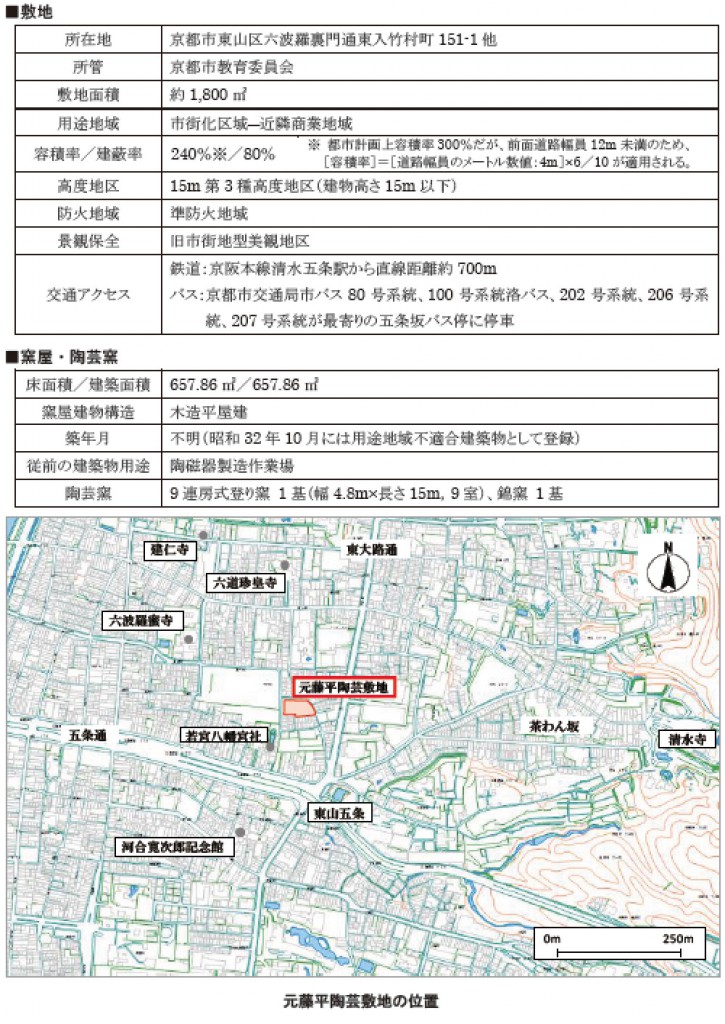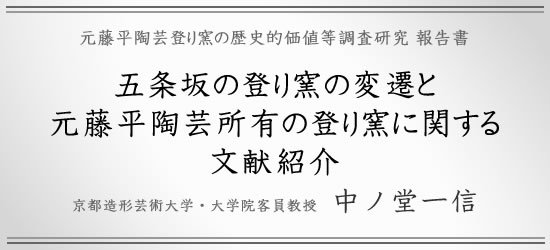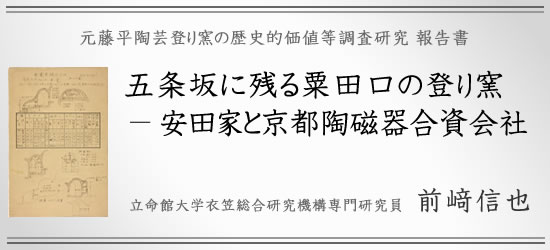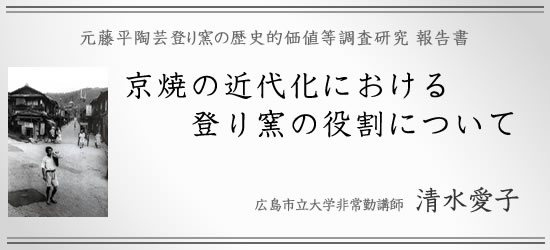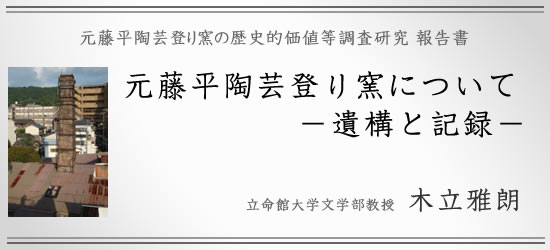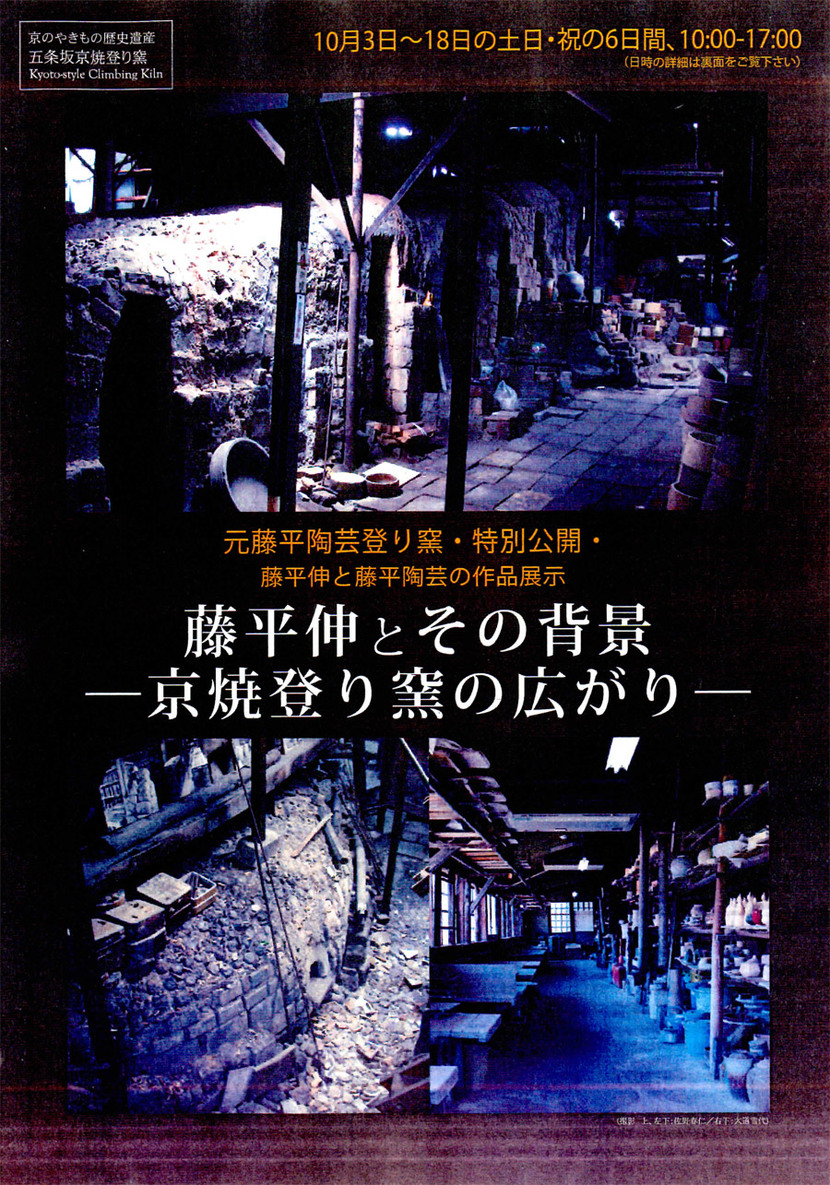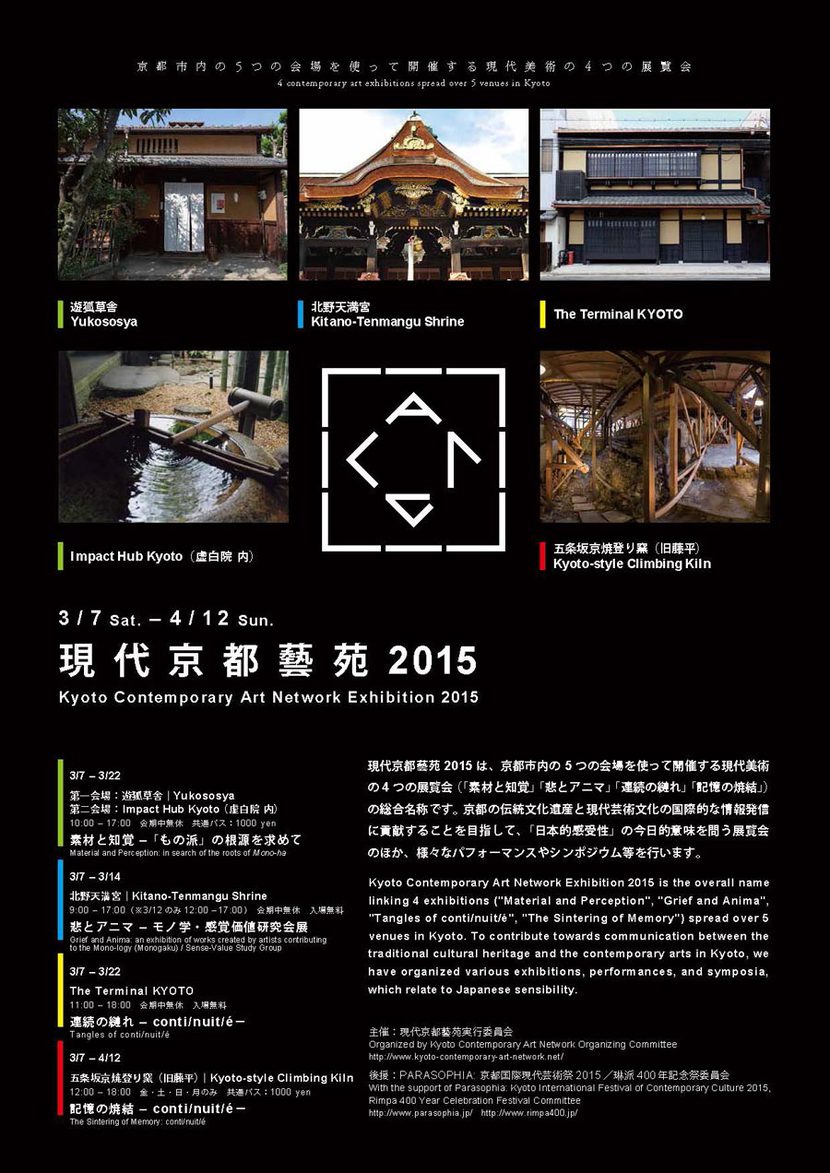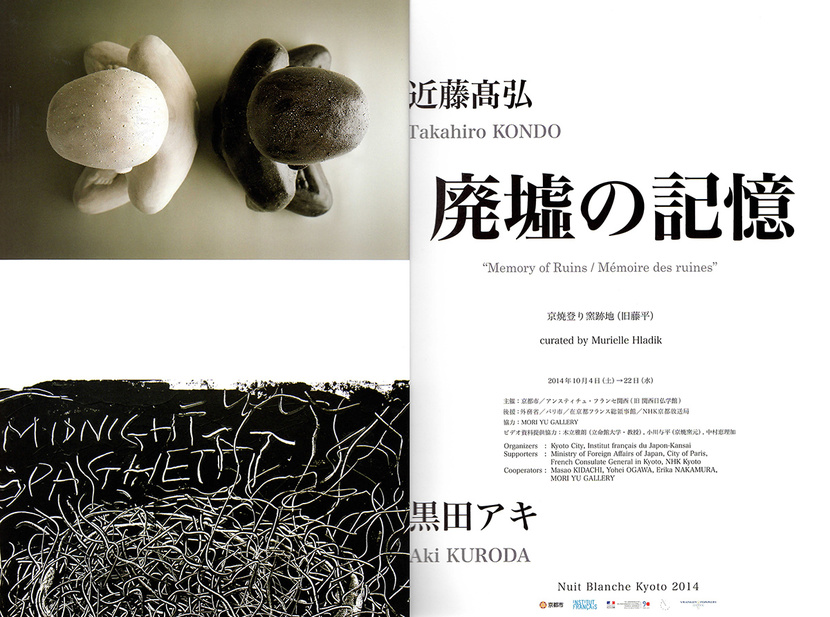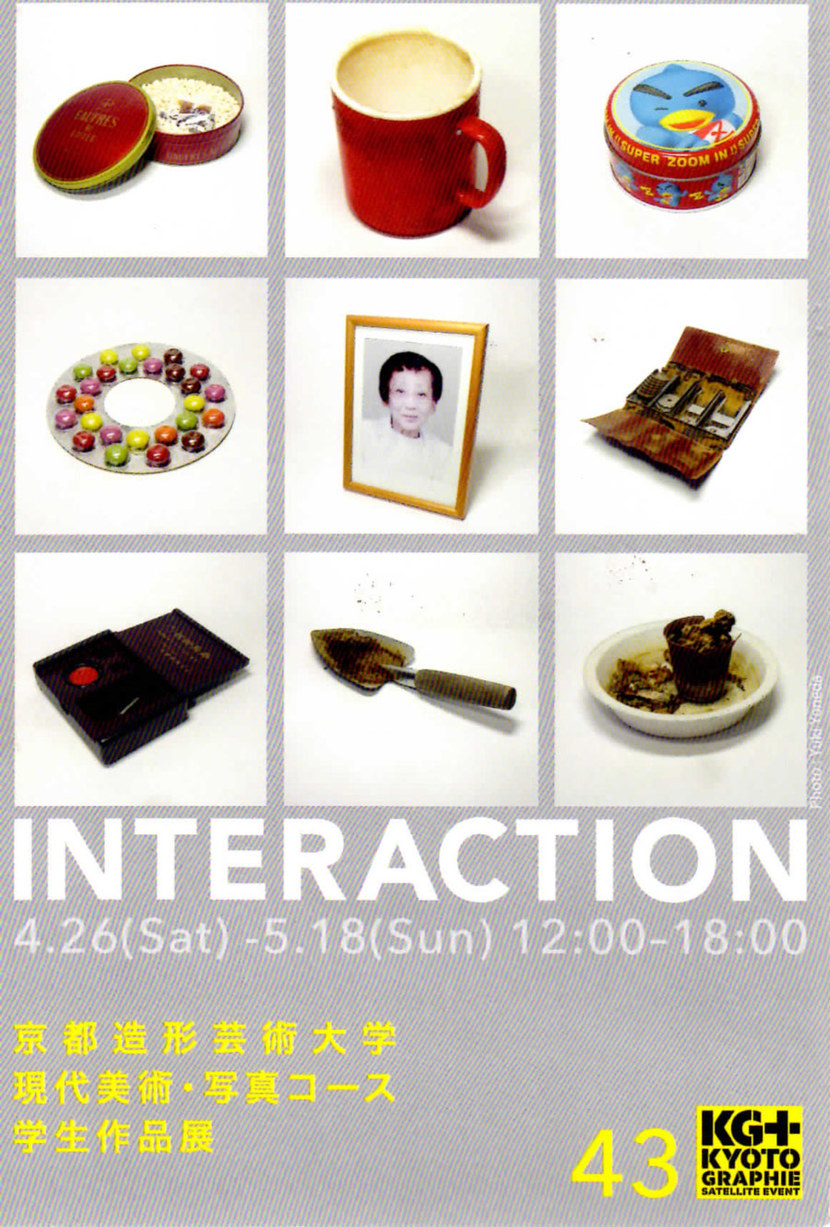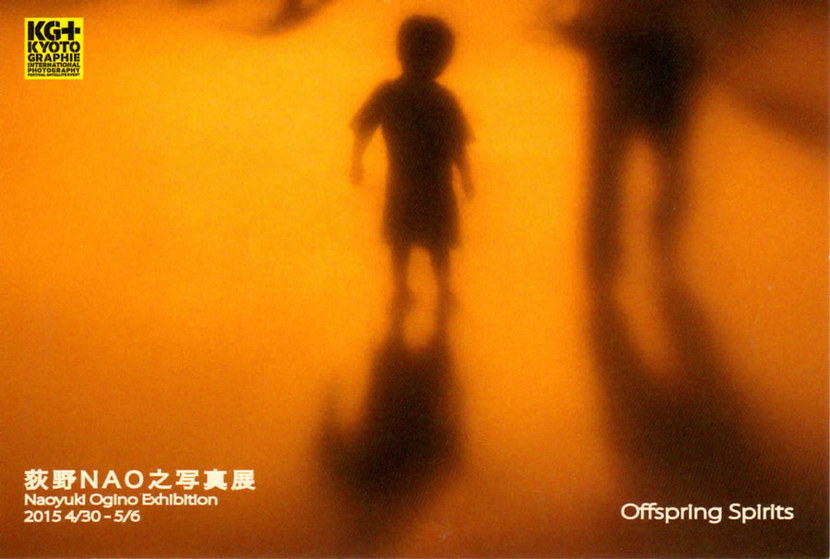元藤平陶芸登り窯の歴史的価値等調査研究 報告書
元藤平陶芸登り窯の概要
1.元藤平陶芸登り窯と清水焼
元藤平陶芸登り窯は、五条坂地区に残された数基の登り窯の一つである。戦前から戦後にかけて、多くの清水焼の登り窯が操業を停止し、窯そのものが失われていったが、そのなかで操業当 時の姿をそのままに留めている貴重な歴史遺産、文化遺産といえる。
京都東山山麓の粟田口、五条坂、日吉、泉涌寺の一帯は、昭和30年代まで、数十基の窯が稼 働する京焼の一大産地であった。京焼の歴史は江戸初期(17世紀前半)に始まるが、すでに17世紀の終わりには五条坂周辺でもやきものが生産されていた。当時の文献『菟芸泥赴(つぎねふ)』(1684 年刊)には「清水の音羽の滝の流れの東なればなり。そのあたりに今焼の器物さまざまに営めり、音羽焼とて京師もてはやす」とあり、この地を流れる音羽川にちなんで「音羽焼」と呼ばれていたことがわかる。
18世紀に入ると、「音羽焼」は清水坂地区で焼かれていた「清水焼」と一体化して発展し、やがて五条坂の北側にも新たな窯が築かれるようになった。明治維新以降、遷都によって大きな影響を受けた清水焼の関係者は、存続のために力を尽くし、明治期には常に20基を越える窯が五 条坂一帯で操業していた。
元藤平陶芸登り窯が築かれたのは明治が終わる頃で、京都陶磁器合資会社によって明治42年6月に築造された。同社は、輸出陶磁器の生産を目的に、明治 29 年に粟田口に設立されたが、この登り窯でも花瓶をはじめとする輸出用の製品の素地が主に焼成されていた。窯の規模は非常 に大きく、かつてはもう一基の窯が現在の窯と向かい合う形で築かれており、京都では大規模といえる生産体制を誇っていた。
その後、昭和 20 年 7 月に窯の所有は藤平窯業有限会社に移った。同社は、戦時中の昭和 17 年に政府から下された企業合同の命令を受け、翌年1月に設立された企業体である。厳しい物資 統制が敷かれた戦時下でも、登り窯では金属製に代わる陶製の手榴弾の弾体等の生産が続けられた。また戦後になると、藤平窯業有限会社の窯として多種多様な製品が焼かれた。そのなかには 理化学陶磁器や河井寛次郎の影響を受けた民芸陶器なども含まれる。
登り窯は、戦時下の物資統制や、五条坂で戦争末期に行われた区画整理による移転など、数々の困難な状況を潜り抜けて操業を続けてきたが、戦後は五条坂周辺でも電気窯への転換が進んだ。 さらに昭和 43 年には大気汚染防止法、昭和 46 年には京都府公害防止条例が施行され、登り窯に対して届出義務及び排出規制が課されたが、それに伴い、藤平陶芸でも昭和 43 年には登り窯の歴史が閉じられた。その後も作業場や電気窯は使用されてきたが、平成 20 年に登り窯を含む敷地全体が京都市の所有となった。電気窯やガス窯、作業場等は比較的近年まで使用されていたため、窯本体のみでなく、周辺も含め、現在もなお操業当時の雰囲気のままに全体が残されている。
2.登り窯の経歴と現状
京焼では登り窯は窯築師と呼ばれる専門の職人によって築かれた。当初の姿では、2基の連房式登り窯が山状に向かい合っており、全部で 17 の焼成室からなる巨大な窯であったが、後にうち1基が取り壊された。その理由は、戦時中に軍用の大型の製品を焼成する石炭窯を築くためであったと考えられる。
現在の窯は、全長 19m(煙突の部分を含めて)、全幅 5.5m、全高 6m で、胴木間(一番手前の燃焼室)と9つの焼成室から成り、焼成室全体の容積は 102 m³に及ぶ。
ここでは自然の傾斜地を生かすのではなく、盛り土によって傾斜地を造成して窯を築いている。また胴木間は地上より下に掘り込まれており、市街地の狭く平坦な土地に窯を築くための工夫と推測される。側壁の下半分は約 40cm の厚みがあり、通常の窯よりも頑丈につくられている。そのためか、阪神淡路大震災の際にも全く損傷を受けていない。
戦後の使用状況では、一の間から三の間で磁器、四の間以降で陶器を焼いており、他より大きい九の間は素焼きに使用されていた。特にむずかしいとされる磁器の焼成は、窯焚師と呼ばれる専門の職人が請け負っていた。
近年の発掘調査によって、2基の登り窯のうち1基が失われただけでなく、残った1基も当初の姿に変更が加えられていることがわかった。横幅はかつては7m近くあったと推定され、前方部は扇形に広がっていた。一方、後方部分の窯の幅が当初より狭くなっていることが判明している。同時に煙突のすぐ脇に隠れていた錦窯(上絵に用いる低火度の窯)も見つかった。京都で残っているのはここだけである。
なお一部が残っている赤レンガの煙突の建造年代は、現時点では不明である。
元藤平陶芸登り窯の敷地概要
Introduction
1. Fujihira Climbing Kiln and Kiyomizu Ware
The Fujihira Climbing Kiln is one of several kilns surviving today in the Gojo-zaka area. During the period before and after the Second World War, many climbing kilns (Noborigama) for Kiyomizu Ware (Kiyomizu-yaki) ceased operation and were demolished. Therefore this kiln is a precious cultural asset, which maintains its original style.
Located on the outskirts of the Higashiyama mountain range, Awata-guchi, Gojo-zaka, Hiyoshi and Sennyu-ji used to constitute the area for the production of Kyoto Ware (Kyo-yaki), with dozens of kilns existing until the 1950s. The history of Kyoto Ware dates back to the early 17th century, by the end of which ware began to be produced in the Gojo-zaka area. According to the document Tsugi-nefu published in 1684, “A new ware business started to the east of the Otowa Waterfall in Kiyomizu. This ware is called Otowa Ware (Otowa-yaki) and is quite popular in Kyoto.” Otowa Ware was named after the Otowa River, which runs through this area.
In the 18th century, Otowa Ware was integrated into Kiyomizu Ware, which was produced in the Kiyomizu-zaka area. Soon this business expanded to the north of the Gojo-zaka area. After the Meiji Restoration (1868), the Kiyomizu Ware business suffered badly from the relocation of the Capital of Japan from Kyoto to Tokyo. During the Meiji Era, people engaged in this business made a great effort to maintain it, securing more than 20 kilns in the Gojo-zaka area on a constant basis.
The Fujihira Climbing Kiln was constructed in the Meiji Era. It was constructed in June 1909 by the Kyoto Ceramic Joint-Stock Company, which was established in 1896 in the Awata-guchi area to produce ceramics for export. This climbing kiln was mainly used to fire unglazed ceramic items such as flower vases. Another large kiln used to sit face to face with the Fujihira kiln. These two kilns comprised the large scale production system of Kyoto.
In July 1945, this kiln was obtained by the Fujihira Ceramic Company Limited, which was established in January 1943 by order of the national government in the previous year. Under the strict material-control system imposed during the war, the company produced hand-grenade parts made of ceramic instead of metal.
After the War, Fujihira Ceramic Company produced various products and artworks. Among these ware items produced were acid-resistant ware for chemical factories or wares in the style of folk art that were influenced by Kanjiro Kawai (1890-1966), one of the leading ware artists in the area.
The climbing kiln survived many difficulties such as the material-control system and the relocation through the land-readjustment project during the War. After the War, electric kilns were introduced in the Gojo-zaka area. The Air Pollution Prevention Act promulgated in 1968 and the Kyoto Prefectural Ordinance on Environmental Pollution Prevention in 1971 stipulated the duty of reporting the use of climbing kilns and constraints on emissions. Thus the Fujihira Ceramic Company’s Climbing kiln closed in 1968, with the electric kilns continuing to operate. In 2008, the entire premises of the company including the Climbing kiln were obtained by the City of Kyoto. Since the electric and gas kilns and the working space were used until recently, the site still maintains the atmosphere of a company in operation.
2. The History and Present State of the Climbing Kilns
In Kyoto, climbing kilns (Noborigama) were produced by kiln-making specialists. Originally this kiln used to have another kiln placed face to face, forming the shape of a mountain. They were very large kilns with 17 chambers in total. Later one kiln was demolished. The exact reason is unknown, but one theory is that it was needed to construct a coal kiln for firing large army assets. Another is that the kiln was too large to circulate the fire to its extremities, and failed to produce good –quality wares.
The present kiln has a length of 19 meter including the chimney, a width of 5.5 meter, and a height of 6 meter, with 10 firing chambers including the front chamber called the dogi-ma. The combined capacity of the chambers is 102 cubic meters.
Here the slope has been constructed artificially by piling up soil instead of using a natural hill slope. The dogi-ma was placed underground to create a tilt on a piece of flat land in the urban area. The lower part of the side wall is as thick as 40 cm, rendering the kiln more robust than others. This was perhaps the reason why this kiln was unscathed when Kyoto was hit by the Great Hanshin–Awaji Earthquake.
After the War, the first to third chambers of the kiln were used for firing porcelain and the remainder used for firing wares. Since the ninth chamber was the largest, it was used for firing earthenware. As porcelain was difficult to fire properly, a specialist called a kamataki-shi used to handle it.
A recent excavation revealed that of the two kilns, one was destroyed and the other had been altered from the original style. The original width of the kiln was estimated to be 7 m. The front of the kiln was shaped like a fan and the back was narrower than expected. The excavation found a Nishiki-gama (low-temperature kiln used for firing decorated ware) next to the chimney. This is the only Nishiki-gama extant in Kyoto. The excavators could not determine when the brick chimney was constructed.


